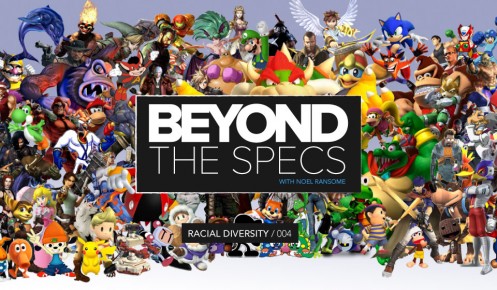“Games is this thing that’s pretty much dominated by white guys,” says former Rockstar Games employee, Shawn Allen at a North By Northeast (NXNE) panel discussion. “I had been really ignorant of the lack of diversity in the workforce in my industry for a while, but once I noticed it I couldn’t stop paying attention to it or stop bringing it up.”
It’s a rarity to hear anyone within the video game industry make this sort of honest declaration like Allen did in a conversation about urban Black and Latino professionals in gaming. Like some pixelated elephant in the room, our digitized playgrounds rarely flirt with this area of discussion despite the industry’s varied audience. From the perspective, as a black man, I’d say that it’s hard to blame the industry for its palpably awkward stance towards race in games. When you lack the cultural credence within your workforce, you can’t be wholly criticized for not knowing how to address it: you know what you know.
I imagine within the industry machine, much like that privileged white friend of mine that occasionally attempts to have a conversation about race, the triggers are everywhere: the presumptions, accidental generalizations and the clumsy verbal tip-toeing that says, “If I don’t talk too much about it, pretend I’m colour blind, I won’t offend anyone.”
That avoidance of a conversation is helped by the fact that video games exist as a form of entertainment and that’s the philosophy the industry has been founded upon. This fact alone makes it far easier to stay stationary and settle in with the norm, because at the end of the day it’s about the “fun” right? You wouldn’t have found me having these meticulous thoughts as I played as Balrog in Street Fighter for instance or Killer Instinct’s own token black combatant, T.J. Combo – both boxers by the way. But as I grow older I naturally expect the industry I’ve participated in to grow with me, as it ought to.
We’ve seen other entertainment industries feel perfectly at home with the norm as well, until names like Ray Charles, Nat King Cole, Billie Holiday and B.B. King started popping up on the music stage. Let’s not also ignore the film industry that began with pivotal ethnic roles like the mammy, house servant, or common thug, which have a striking resemblance to familiar stereotypes found in the gaming landscape.
Lack of Representation
“There’s common themes in games that just include throwing minorities to the wind with poor characterization, lack of attention to cultural detail and behaviour,” says Allen. “All the while lining up dozens to be murdered or just leaving them out of speaking roles other than service people, farm hens or criminals. So this is what I was having to work on.”
• Sazh Katzroy (Final Fantasy XIII) – Comic relief/buffoon
• Sergeant James Heller (Prototype 2) – Main character/anti hero
• Sheva Alomar (Resident Evil 5) – Side character
• Aveline De Grandpre (Assassin’s Creed III: Liberation) – Main character / ill advertised DLC game
• Carl Johnson (Grand Theft Auto: San Andreas) – Main character/thug
• Barret Wallace (Final Fantasy VII) – Sidekick / Angry black man with a hand for a gun
• Elena (Street Fighter III) – Kenyan fighter/non popular
• Franklin Clinton (GTA V) – Main character / Repo man
The industry is colour blind
“Video games have not been historically Black or Latino, that’s the truth. Games in the west were created, the market crashed and Nintendo, a Japanese company, brought it back,” says Allen. “You would see commercials for the games that would bring you to the Japanese, Nintendo factory and see people making them. They would show you white kids playing the games on commercials or in documentaries. It’s kind of interesting, little kids would see this and you wouldn’t see yourself in the commercials, wouldn’t see yourself in the games, and wouldn’t see yourself anywhere near this.”
It’s not so much that the developers themselves don’t care, it’s because there is a disconnect within the industry that has always catered towards and advertised itself towards the white male. Minorities and gamers in general have been dosed with a normalcy that the most accepted and successful sort of individual within the development scene is white. A 2005 study by the International Game Developers Association stated that white people made up 85 per cent of game industry workers, followed by Asian people at 7.5 per cent and African-American and Hispanic people respectfully at 2 to 2.5 per cent.
This gives the medium a fenced-off appearance to those that live in worlds that differ from the average worker. The film industry broke free of those enclosures by giving birth to varying levels of brutal honesty about alternative cultures through Boyz in the Hood, Guess Who’s Coming to Dinner, The Color Purple and A Raisin in the Sun, among others. Music managed it by defying expectations through larger than life personalities like early rock and roll stars Chuck Berry and Jimi Hendrix who brandished guitars in addition to a voice.
Video games in respect to the worlds, characters and mechanics that make them successful do not consist of real individuals who come in with their own “Black” or “Latino” experiences. You won’t see minorities storm in and change an entire viewpoint or tech culture based on undeniable acting abilities or uniquely soulful sounds. Change can’t happen in the same form, because it’s the creators and industry execs that rule.
Change won’t come from within
“There was a while where I was all about getting minorities into the Triple A game scene, but you learn that these are huge machines that are dealing with so many people – it’s impossible to change unless you’re at the top of the pyramid,” says Allen. “People for the most part seem to be fearful of tackling any of these details in any real manner, because they don’t want to lose sales.”
It’s not that there aren’t mindful individuals that aren’t aware of the lack of diversity within their field. But the truth is that to be the first takes motivation and guts. To make a change comes with an understanding that growing pains will start with you. It means that if you say the wrong thing, give off the wrong impression in regards to race, it can be like that same friend who would much rather avoid the conversation than inadvertently offend due to a lack of exposure. It will also put you in a place where you set the standard, and whatever values pulled from your idea of what’s respectful to a culture that isn’t your own, will be securitized from both sides. A person of minority understandably doesn’t have to worry about “sensitivity” issues when it comes to cultural portrayals. Words like racism and ignorance leveled towards a white developer will get turned to modern day Blaxploitation as some in the film world accuse Tyler Perry of.
That same level of motivation and guts that’s needed to make a change historically came from those who felt targeted and wronged. In the same way that I do my part as a black journalist by providing a perspective unique to where I’ve come from, it’s equally in the hands of Black or Latino people within the independent developer scene to provide that sense of representation. The kind of depiction that doesn’t place minorities in an archetype, but in a role that makes them seem just as normal with traits unique to their upbringings.
Diversity is necessary
This is a medium that generates billions each year and is quickly replacing film and television as the primary method of entertainment for young children. Compare that to the fact that it’s still the least diverse industry of them all. If all children know of certain cultures years from now comes from the depictions illustrated in today’s standard of games, it would hardly be a surprise to find rampant racism, sexism and general bigotry among its growing audience, within its discussion forums and online spaces. True change in diversity within this industry isn’t going to come from some BS black character option in a create-a-player menu. It’s going to have to come from those with an understanding of how they want to be portrayed.
@NoelRansome




4 Comments
Great article, brother Noel! Very insightful/inciteful and forward-leaning. Much more must be written about this disparity in order to influence people of color to want to infiltrate the industry and have the industry welcome their addition and inclusion. Perhaps if they (people of color) knew of the billions of dollars generated yearly by this artform, there would be more candidates filling the seats in the game development classes at Universities around the world! Can we look forward to a follow-up article on this subject? Yes? Keep up the good work!
Urbanologists, in my humble opinion your portraits should be included in the byline, as that would aid the reader/viewer in making a connection with you. I doubt that I am the only reader that would welcome that connection. Again, kudus for producing a quality product! Peace.
Thanks for the insight and reading Noel’s article! We actually do have our portraits in those spaces, there is a bug in our backend that is causing them not to show up that is being worked on. Thank you for your patience, understanding and readership!
Pingback: Former Rockstar Games Employee Strives for Change #5 |